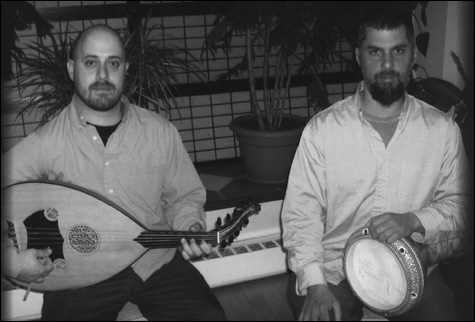
STAID DUO: On worldwide journeys. |
Raise your hand if you know where Anatolia is.
Liars.
That’s unfair. I’m sure some of you were geography majors in college and are totally aware of Anatolia’s crucial place in the creation of civilization. You might also know it as Asia Minor (that’s a place I could pick out on a map), the peninsula that forms the Asian part of Turkey and was named by the Greeks in reference to that land east of Constantinople (now known as Istanbul, as any They Might Be Giants fan is well aware).
As the bridge between Asia and Europe, it is very much the Middle East and saw Phrygians, Cimmerians, Lydians, Persians, Celts, Tabals, Greeks, Assyrians, Armenians, Romans, Goths, Kurds, and many more cultures set up shop among its mountains and plains between the Black and Mediterranean seas. As you might imagine, that has led to an incredibly rich culture in what is now Turkey, and Okbari have done us all a serious service by honoring the memory of their mentor, Alan Shavarash Bardezbanian (a/k/a Al Gardner), with a 14-song disc exploring the musical heritage of Anatolia and Armenia, a musical heritage Bardezbanian brought to Maine, virtually unassisted for decades, before he died far too early in late 2006, at the age of 56.
The unassumingly titled Armenian and Anatolian Folk Music is enjoyable on its own merits, with impeccable playing of often upbeat and danceable tunes that ought to appeal most to bluegrass and math rock fans. It is also, however, a reason to think about a region of the world most of us don’t know a great deal about.
Okbari have done this for us before. Amos Libby and Eric LaPerna released a self-titled disc this time last year, and introduced themselves to Portland and beyond with their debut full-length, By the Banks of the Red River, in 2004. Both times, I marveled at their ability to take the foreign and make it familiar, in a time when so much of our attention is focused on the very volatile part of the world from which the pair take their musical inspiration.
What they most succeed in doing is conveying a sense of how old and textured this music is. Compared to the poppy indie and radio rock that mostly comes across my desk, this sounds positively ancient, which, of course, it is. My favorite tune, “Rompi Rompi,” is popular enough that I found a translation telling me it’s about a savvy trader named Rompi who is encouraged to “let Halime’s navel jiggle.” The song has swagger, with LaPerna’s quick percussion punctuated by hand claps and Libby’s vocals seemingly unable to resist cries of “hai!” (This is apparently the song to play for a dancer who requests a “karsilama,” or song in 9/8, and Wikipedia tells me that some international folk dance clubs do a line dance to the piece.)
Without trying to get too political, it’s hard not to think about how arrogant Americans are when you hear this stuff, like a bunch of toddlers refusing to listen to their parents. Our 300-odd years of history seem like the blink of an eye compared to the millennia that have gone into the creation of these folk songs. The range of the stringed oud, both bassy and bright, is like the breadth of the region’s history.